Chelsea grab 3 vital points at Carrow road with spectacular goals from Oscar, Hazard and Willian. However in more important news , I missed the first 40 minutes of the season. So this analysis will cover only the second half.
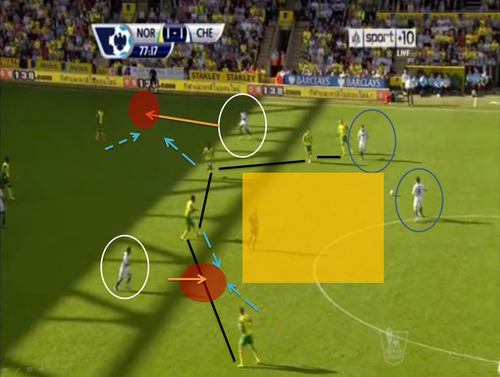
Here we see Norwich’s defensive block ahead of the 4 defenders. The striker joins in, creating an effective defensive formation of 4-5-1. This enables them to move along the pitch laterally as a unit, thus reducing the amount of holes that can be exploited.
Norwich were reluctant to press when organized. As can be seen from the screen grab, the yellow area is the zone of pressure, which no Norwich player is ready to jump into. Their first priority is blocking of passing lanes to the players encircled in white, who can attack areas encircled in red . The Norwich players, who have pressing movement (blue dotted arrows) , are the one’s assigned to cut off direct passing lanes.
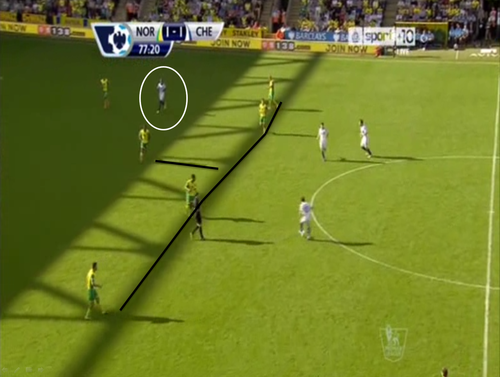
We further explore Norwich’s second defensive line. Well structured, but gives you false hope of an exploitable hole. They can easily be pressed when they try to directly penetrate it. The player encircled in white is isolated. If a ball is played to him, Norwich will jump on him. Pilkington’s pressing in this phase of play had been fantastic.
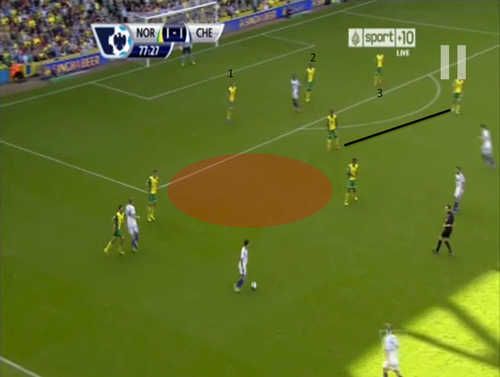
Here we notice Norwich’s reluctance to press until a player enters a zone. Hazard has the ball and evaluates his option. No doubt that he has the ability to burst right at them, and he tries to do so.
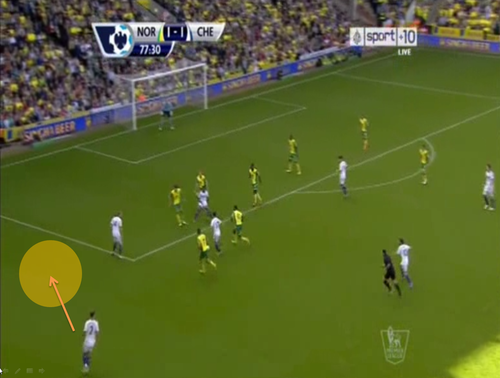
The moment he enter’s, a red exclamation mark lights up on top of his head. The midfielder’s press and reduce his passing options. We can also note that by doing this, Norwich exposed themselves on the sides due to pressing too narrow. Hazard could lob the ball in Ivanovic’s direction, and we could have the ball in.
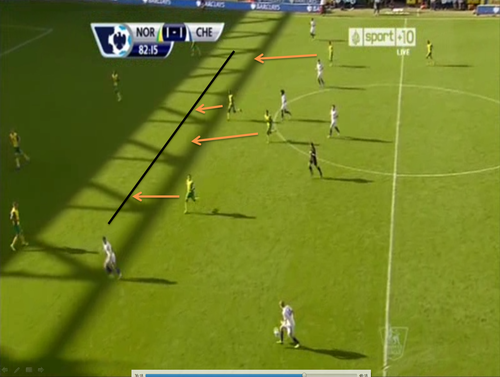
Here is a note on Norwich’s defensive transition. The players retreat and form a defensive block before the attackers are able to organize themselves. This gives them a numerical advantage if the ball is played narrow, and also help them cover for each other by covering up holes with 80% zonal and 20% man marking.
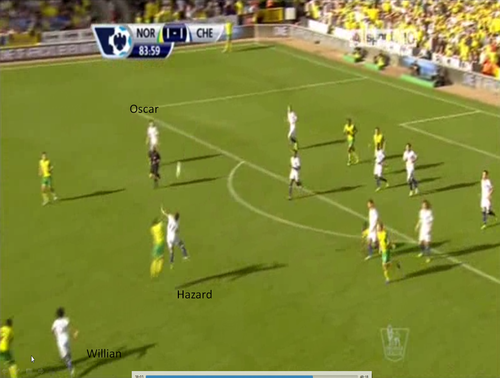
Moving on to the goal. A poor poor corner by Pilkington, and Luiz clears the ball away. Hazard has quite a jump as he head’s the ball towards Willian. Oscar begins initiating a counter-attack by making the first run.
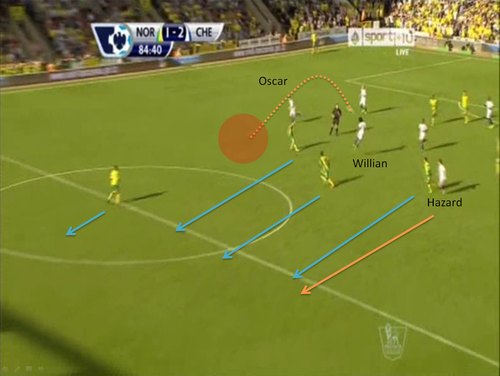
Willian literally heads the ball first to himself, which turns out to be a bit weak. He then heads it again, but more powerfully and onto the path of Oscar. Hazard has now realised that the ball will come to him at the end of the day. Norwich meanwhile are retreating back as fast as possible.
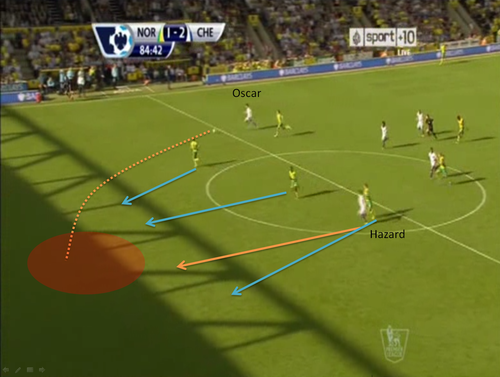
Oscar gets ready to curl the ball in. Tettey will try to reach it before Hazard, which he does. But could he have prevented the goal, or was it the fault of the two defender’s retreating with him?
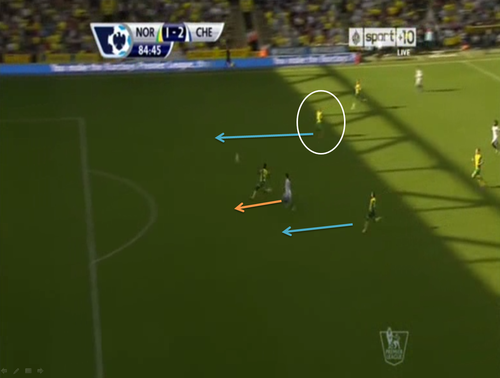
Tettey is a right footed player, but still opts to clear the ball with his left. -1 to him. The defender encircled in white makes a mistake of stopping his run. He should actually have continued and come alongside Tettey, Hazard would have had no chance of scoring then. Instead he slows down. -1 to him too. However it seems that it wasn’t too hard for Tettey to clear with his right, but that’s an opinion in hindsight.
To sum it up, Hazard made a terrific run, and deserved a goal for the effort he put in. Tettey on the other hand could have made a better clearance, while the Norwich player could have kept retreating. A collective mistake.
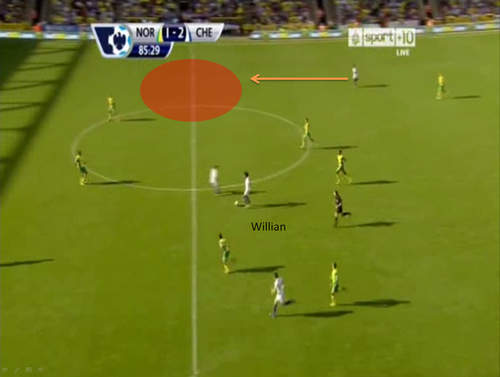
Everyone seems to have made up their mind that Willian’s goal was in fact the result of a counter-attack. For me though, a cloud of mystery still looms around it.
Willian here receives the ball after Norwich are dispossessed. The best indicator of a counter-attack is that even the common eye can spot an exploitable hole, which in this case is an area encircled in red that can be penetrated directly by Chelsea. However WIllian moves along with the ball.
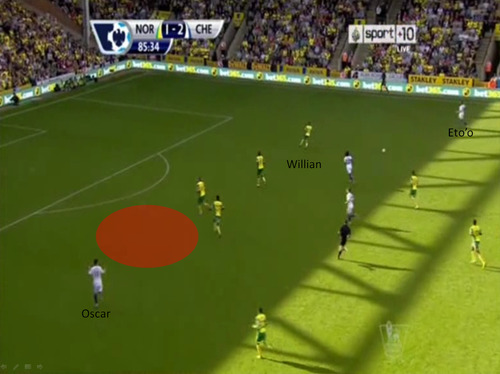
Willian gives it to Eto’o and now we see another area encircled in red that can be directly exploited. The fact is that, over the two screen grabs, Norwich are retreating faster than Chelsea are pushing up players, which makes this either a lazy counter-attack, or just another medium to waste time. 7 Norwich yellow players directly against 4 in Chelsea white.
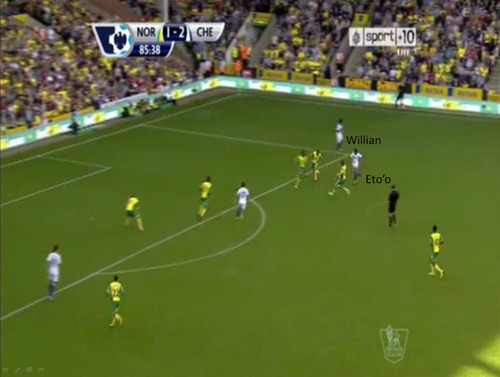
Here we see Eto’o cutting in, and losing the ball only to be picked up by Willian who curves it into the back of the net. A peach of a goal . However if you notice, the entire Norwich structure has been organized, removing the theoretical effect of a counter-attack.
By definition – The general objective is to negate or thwart the advantage gained by the enemy during attack, whilst the specific objectives typically seek to regain lost ground or destroy the attacking enemy.
The fact that whether Chelsea were trying to destroy the enemy is debatable. If they were indeed trying to, they could have been faster, considering Hazard and Willian were just brought into the game.
Regain lost ground refers to pushing your players ahead and giving you a numerical advantage, which Chelsea fail to do so by the time the shot is unleashed.
If I were to write this goal down in a file and put it in a briefcase, I would print out a huge question mark and stick it on one of it’s sides. Let the debate, begin.
Published in permission with Sherry Philips
